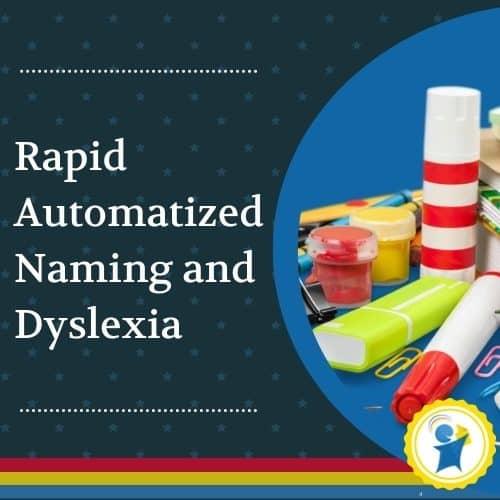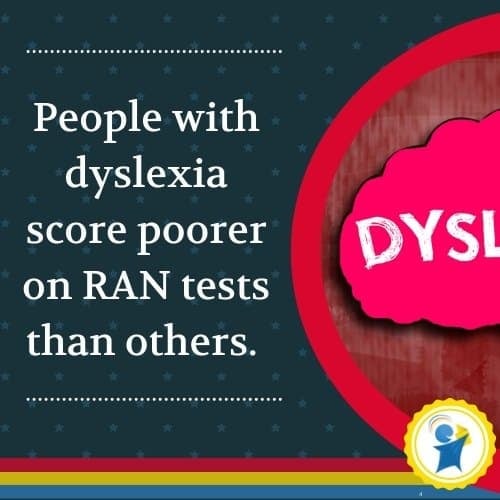
Research on rapid naming, or rapid automatized naming, began with the work of Denckla and Rudel. Rapid automatized naming (RAN) refers to the speed with which one can retrieve the names of symbols (letters, numbers, colors, or pictured objects) from long-term memory. Dyslexia has been linked to poor rapid naming.
Table of contents:
- Dyslexia and poor rapid naming
- Rapid naming as part of a phonological deficit
- Rapid naming as a separate construct
- How is rapid naming measured?
- Is rapid naming holding your child back?
- Key takeaways
Dyslexia and poor rapid naming
People with dyslexia score poorer on rapid automatized naming assessments than typical readers (Elliott & Grigorenko, 2014). Dyslexia is a general term for a learning disorder that involves difficulty learning to read or interpret words, letters, and other symbols, but that does not affect general intelligence.
A meta-analysis of 137 studies of 28,826 participants indicated a moderate-to-strong relationship between RAN and reading performance. Further analyses revealed that RAN contributes to the four measures of reading: word reading, text reading, non-word reading, and reading comprehension. However, higher correlations emerged in favor of real-word reading and text reading. The authors conclude that there is “still no consensus regarding the mechanisms responsible for this relationship” (Araújo et al., 2015, p. 869).
Rapid naming as part of a phonological deficit
Phonological processing skills are believed to play an essential role in reading development. Phonological processing refers to using the sound structure of one’s oral language to process written language (i.e., reading, writing) and oral language (i.e., listening, speaking).
Some scholars view deficits in rapid naming as part of the phonological deficit in poor readers. They believe that phonological processing consists of three main components:
- phonological awareness,
- phonological or verbal short-term memory, and
- rapid automatized naming.
.
Phonological awareness involves the detection and manipulation of sounds at three levels of sound structure: (1) syllables, (2) onsets and rimes, and (3) phonemes.
- A syllable is a unit of pronunciation having one vowel sound, with or without surrounding consonants, forming the whole or a part of a word; for example, there are two syllables in water and three in inferno.
- The onset is the consonant sound or sounds at the beginning of a syllable. The rime is usually the portion of a syllable from the first vowel to the end. For example, /æt/ is the rime of all the words at, sat, and flat.
- A phoneme is a unit of sound that distinguishes one word from another in a particular language. For example, the sound patterns /sɪn/ (sin) and /sɪŋ/ (sing) are two separate words distinguished by the substitution of one phoneme, /n/, for another phoneme, /ŋ/.

Phonological or verbal short-term memory is the ability to hold speech-based information in short-term memory. We rely heavily on our phonological memory when reading and spelling.
Ziegler et al. (2010) examined the influence of phonological awareness and rapid automatized naming across five languages: Finnish, Hungarian, Dutch, Portuguese, and French. They found phonological awareness to be the main factor associated with reading performance in each language; its impact was stronger in less transparent orthographies. Transparent orthographies have a one-to-one relationship between their graphemes and phonemes, and the spelling of words is very consistent. However, the influence of rapid automatized naming was relatively weak and limited to reading and decoding speed.
Rapid naming as a separate construct
While some view rapid naming as part of the phonological deficit in poor readers (Ramus & Szenkovits, 2008), others, like Wolf and Bowers (1999), claim that it constitutes a separate construct.
According to Wolf and Bower’s double deficit hypothesis model, people with dyslexia can be subdivided into three groups:
- those with phonological awareness difficulties but with average rapid automatized naming ability;
- those with a rapid automatized naming deficit but average phonological awareness; and
- those with both phonological awareness and rapid automatized naming difficulties. According to this model, those with a double deficit likely have the most severe form of reading difficulties.
In a longitudinal study, Landerl et al. (2018) examined 1,120 children acquiring one of five alphabetic orthographies with different degrees of orthographic complexity: English, French, German, Dutch, and Greek). While rapid automatized naming was a consistent predictor of reading fluency in these five alphabetic writing systems, no consistent pattern appeared for the phonological awareness–reading relationship.
The researchers conclude that phonological awareness’s direct contribution to reading development might be less causal than is generally assumed. They speculate that phonological awareness may function as a corequisite skill for typical reading development instead of being a prerequisite for learning to read.
How is rapid naming measured?
While the debate about rapid naming is ongoing, the strong correlation between dyslexia and difficulties with rapid naming justifies its inclusion in dyslexia tests. Two tests are widely used:
Rapid Automatized Naming and Rapid Automatized Stimulus (RAN/RAS Test)
This test measures the rapid naming abilities of children five years of age and older. The child must name items as quickly as possible to complete the test. The examiner times the child and comes up with a score based on how long it took the child to complete the test and how accurate the answers were. The test includes a variety of stimuli: colors, objects, numbers, and letters. The stimuli are high frequency, meaning they are things the child will have experienced or encountered often. This test can help an assessor predict or diagnose a reading problem.
Speeded Naming subtest of the NEPSY Assessment
NEPSY is the name given to a battery of tests whose full title is: “A Developmental Neuropsychological Assessment.” One subtest, the “Speeded Naming” test, measures rapid naming speed in children. As with the RAN/RAS test, the examinee’s score comes from both the speed and accuracy of naming. An examiner may also draw conclusions about other behaviors, such as impulsivity; an impulsive child might name rapidly but inaccurately. Conversely, a child might name adequately during the example at the beginning of the test, which is untimed, but fall short when speed is required. These two outcomes have different implications for the kinds of recommendations an examiner might make. It can also inform a prediction or diagnosis of a reading disorder.
Is rapid naming holding your child back?
Edublox Online Tutor is an online platform that houses a range of products and services to improve various aspects of learning. Our programs include Development Tutor, Reading Tutor, and Live Tutor. Live Tutor works in conjunction with Development Tutor, is recommended for students with mild to severe dyslexia, and aims at
- strengthening cognitive skills, including rapid automatized naming;
- teaching decoding, an essential skill for learning to read that involves taking apart the sounds in words (segmenting) and blending sounds; and
- developing orthographic mapping.
Book a free consultation to discuss your child’s learning needs..
